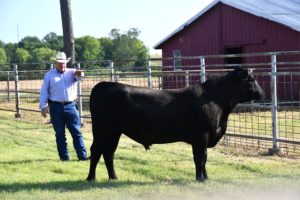Stiles Farm Field Day features herd bull selection, cropping systems alternatives
Writer: Blair Fannin, 979-845-2259, [email protected]
Contact: Ryan Collett, 512-898-2214, [email protected]
THRALL – Stiles Farm Field Day attendees learned more about the possibilities of using low or high crop input methods, plus tips on purchasing breeding bulls used in beef cattle operations.
The 54th field day attracted more than 100 producers from across the Blacklands region. Dr. Ronnie Schnell, Texas A&M AgriLife Extension Service cropping systems specialist, College Station, discussed high- and low-input production systems for sorghum. The field trial evaluates both low and high inputs of seeding rates, herbicides and fertilization.


“In this study, we know we have really good yield potential in sorghum and have seen good yields from 8,000 to 10,000 pounds per acre in national yield trials,” he said. “What we are trying to find out is if we can capture that on a consistent basis by being aggressive with inputs, using higher seeding and nitrogen rates and more intensive herbicide program overall going after higher yields.”
Schnell said by evaluating the high-input potential, it might pay big rewards come harvest time.
“It may give us a higher return per acre than a conservative approach,” he said. “We are only looking at $30 per acre between high- and low-input trials. At the end of the year, we will see where we end up as far as the difference in yield. Complete production budgets will be developed to look at net returns per acre for contrasting levels of management.”
Meanwhile, Dr. Ron Gill, AgriLife Extension livestock specialist in College Station, discussed herd bull selection for cattle producers. Gill said producers must first decide which direction they are going in their breeding program and what goals they are trying to achieve. Often times producers try to chase extremes when selecting a bull, and it may not fit the type of cattle they have in their herds.
Overall, Gill said, choosing the right bull depends on the type of cattle you have and the goals established in producing market calves.
“It comes down to picking out what you need to do first, understanding the tools to get that done using EPDs, genetically enhanced EPDs and genetic markers,” he said. “There are a lot of tools out there you need to look at before we even physically look at a bull and see if he’s going to meet the needs in our cow herd. It’s just a matter of where you want to go, what the markets are asking for and what you are capable of producing.”
The Stiles Farm Foundation was established by the Stiles family at Thrall in Williamson County. The farm is used by AgriLife Extension and AgriLife Research, which conduct field experiments and use the facility as a teaching platform.


